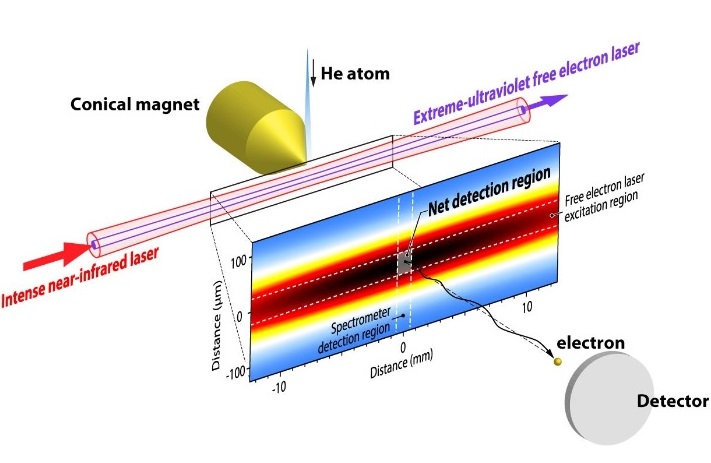(Tokyo, 8 December 2015) Ultrafast and high efficiency manipulation of the quantum states of helium with high power lasers enables the realization of femtosecond two photon Rabi oscillations. The research was reported online in Nature Photonics on 30 November 2015 and has potential applications for room temperature quantum computing.
Toru Morishita at the University of Electro-Communications, Tokyo (UEC, Tokyo) and colleagues at Nagoya University, Toyama University, RIKEN, Japan Synchrotron Radiation Research Institute, and Fu-Jen Catholic University, Taiwan, report on the successful observation of ultrafast femtosecond two photon Rabi oscillations in helium.
Interaction of coherent light—as produced by lasers—with matter results in the generation of ‘superposition of quantum states’. This phenomenon can be used to manipulate matter to go between two quantum states at ultra high speed at almost 100% efficiency. This oscillation between two quantum states in different energy levels under the presence of an oscillatory driving field is referred to as ‘Rabi’ oscillations. Notably, this fundamental physical process can be exploited for applications including quantum information processing.
Inspired by the possibility of such intriguing applications, recent research is in this area is focused on the possibility of generating multi-photon processes. However, to-date, the generation of even the simplest two photon process has required at least pico-seconds of time. In terms of practical applications, to actually manipulate the state of matter necessitates much faster optical processes using more intense light.
On the other hand, the interaction of matter with very high intensities of light leads to changes in the state of the matter itself, with ionization and other such competing, non-linear phenomena becoming dominant, which leads to difficulties in maintaining Rabi oscillations.
Here, the researchers report on the successful manipulation of the quantum states of helium by two photon absorption. The experiments consisted of the use of resonant phenomena of an intense laser field produced by an extreme ultra-violet free electron laser (EUV-FEL) and the near infra-red region of a high intensity femto second laser. See Figure 1. Specifically, Rabi oscillations were observed in the terahertz frequency range, which is three orders of magnitude faster than any previous reports.
These findings are expected to form the basic building blocks of technology for controlling chemical reactions and the room temperature control of the quantum states of matter for quantum computing applications.
Reference Title: Femtosecond two-photon Rabi oscillations in excited He driven by ultrashort intense laser fields
Authors: M.Fushitani1,2, C.-N.Liu3, A.Matsuda1, T.Endo1, Y.Toida1, M.Nagasono2, T.Togashi4, M. Yabashi2,4, T. Ishikawa2, Y.Hikosaka2,5, T.Morishita6and A. Hishikawa1,2*
Journal: Nature Photonics
Published on line 30 November 2015
DOI: 10.1038/NPHOTON.2015.228
1. Department of Chemistry, Graduate School of Science, Nagoya University, Furo-cho, Chikusa, Nagoya, Aichi 464-8602, Japan.
2. RIKEN, SPring-8 Center,Sayo, Hyogo 679-5148, Japan.
3. Department of Physics, Fu-Jen Catholic University, Taipei 24205, Taiwan.
4. Japan Synchrotron Radiation Research Institute, Sayo, Hyogo 679-5198, Japan.
5. Graduate School of Medicine and Pharm aceutical Sciences, University of Toyama, Toyama 930-0194, Japan.
6. Departmentof Engineering Science and Institute for Advanced Science, The University of Electro-Communications, 1-5-1 Chofu-ga-oka, Chofu, Tokyo 182-8585, Japan.
*Corresponding author
http://www.uec.ac.jp/eng/news/announcement/2015/20151215-1.html













